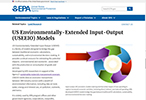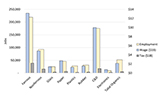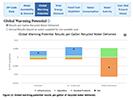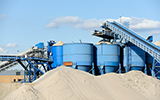This is an archived version of this site. As of October 29, 2024, this site is no longer updated. Franklin Associates is now a part of ERG.
Example Projects
- USLCI Data Curation
Franklin Associates, A Division of ERG is now serving as the data curator for the National Renewable Energy Laboratory's U.S. Life Cycle Inventory (USLCI) Database, which is a U.S. database that industry associations and other organizations can use to publish publicly available life cycle data. Such life cycle data can help life cycle assessment practitioners, researchers and the public understand the environmental impact of different supply chains. ERG provides quarterly updates and improvements to the database and works with organizations across the U.S. to release their data. The winter 2022 release included new datasets for plastic and steel product supply chains. If you have any data you would like to submit to the USLCI, please contact us at uslci@erg.com. The most recent release is available on the Federal LCA Commons in the NREL group repository: https://www.lcacommons.gov, and the update can also be downloaded from the USLCI GitHub Support Content page. - Our Staff Co-Author Papers in Applied Sciences' Special Issue, "Advanced Data Engineering for Life Cycle Applications"
Franklin Associates, A Division of ERG staff have been working with EPA and other collaborators on a series of papers for this special issue of Applied Sciences. These publications describe some of our novel life cycle assessment (LCA) tool development work in Python and R. This ecosystem of LCA tools and models enables robust and transparent calculation of supply chain environmental impacts, such as greenhouse gas (GHG) emissions. The tools mine and harmonize existing government data sources for use in life cycle applications, such as carbon footprinting and consumption-based GHG emissions inventories.- useeior: An Open-Source R Package for Building and Using U.S. Environmentally-Extended Input–Output Models
- A System for Standardizing and Combining U.S. Environmental Protection Agency Emissions and Waste Inventory Data
- FLOWSA: A Python Package Attributing Resource Use, Waste, Emissions, and Other Flows to Industries
- Life Cycle Data Interoperability Improvements through Implementation of the Federal LCA Commons Elementary Flow List
- EPA U.S. Environmentally Extended Input-Output (USEEIO) Model Version 2.0
Our staff have been supporting methodological and data updates for the EPA U.S. Environmentally Extended Input-Output (USEEIO) model to enable calculations of the direct and total environmental impacts of U.S. goods and services. Documentation for version 2.0 was just published in Scientific Data, and a version for use in LCA software was uploaded to the Federal LCA Commons. - Life Cycle Inventories of End-of-Life Pathways of Construction and Demolition Materials
Franklin Associates, A Division of ERG helped develop EPA's end-of-life management of construction and demolition materials life cycle inventory database, which we recently released for public use on the Federal LCA Commons. This is a public federal life cycle database for quantifying complete environmental flows associated with management of construction and demolition debris. ERG also co-authored the EPA report describing the database development.  Regional Life Cycle Assessment Tool for U.S. Electricity
Regional Life Cycle Assessment Tool for U.S. Electricity
ElectricityLCI, developed in coordination with the U.S. Environmental Protection Agency and the National Energy Technology Laboratory, is a system that estimates the entire life cycle of electricity grid impacts at the national, state, and regional levels more precisely than currently available electricity inventory data do. Including Environmental Metrics in the USEEIO Model for Sector and Commodity Assessment
Including Environmental Metrics in the USEEIO Model for Sector and Commodity Assessment
ERG supported the U.S. Environmental Protection Agency in developing the environmental release information for the U.S. Environmentally-Extended Input-Output (USEEIO) model. This model uses a life cycle approach to identify high-level impacts of sectors in the U.S. economy across the full supply chain. The Recycling Economic Information Report
The Recycling Economic Information Report
This study, developed for the U.S. Environmental Protection Agency, assessed the economic impacts of recycling on jobs and tax revenue in the United States for nine material categories using a life-cycle-based waste input-output (WIO) modeling approach. NEWR Calculator
NEWR Calculator
NEWR, the Non-potable Environmental and Economic Water Reuse Calculator, helps identify environmentally effective, cost-effective options for onsite non-potable water reuse for any ZIP code in the United States based on user-chosen specifications. A manuscript developed in conjunction with this calculator used NEWR simulations to assess the suitability of U.S. onsite non-potable reuse options. Incorporating Out-of-State Fuel Cycle Emissions in New York State's GHG Inventory
Incorporating Out-of-State Fuel Cycle Emissions in New York State's GHG Inventory
ERG developed customized fuel cycle results for natural gas, petroleum, and coal for a GHG inventory by the New York State Energy Research and Development Authority. The results identify the locations for fuel extraction, processing, and distribution relevant to New York. PET Plastic Resin Production: U.S. Industry Life Cycle Analysis
PET Plastic Resin Production: U.S. Industry Life Cycle Analysis
This cradle-to-resin model for U.S. average industry production of virgin PET resin was completed for the National Association for PET Container Resources. This model quantified energy and resource use, water consumption, solid waste, and environmental impacts for each step in the life cycle of PET resin produced from purified terephthalic acid. Updates to the GREET Model
Updates to the GREET Model
ERG supported the updating of Argonne National Laboratory's GREET model for use in estimating emissions from traditional and alternative pathways for fuels. This work involved generating comprehensive life cycle inventories for the production of hydrogen from steam methane reforming, and developing refined emissions estimates for specific petroleum refinery products. Assessing the Environmental and Socioeconomic Impacts of Biofuels Production Using Input-Output Modeling
Assessing the Environmental and Socioeconomic Impacts of Biofuels Production Using Input-Output Modeling
In partnership with the National Renewable Energy Laboratory, ERG developed the Bioeconomy Environmentally Extended Input-Output Model (BEIOM). This model expands on the U.S. EPA's publicly available U.S. Environmentally Extended Input Output (USEEIO) model by incorporating data for several "near-commercial" biofuels pathways, enabling a comprehensive assessment of environmental impacts across biofuels including greenhouse gases, eutrophication, and toxicity.- Food Waste Recycling — Environmental And Economic Assessment
As part of a two part series, the first part of this study, developed with the US Environmental Protection Agency, provided detailed global warming and summary results for all environmental impacts assessed for five food waste recycling and disposal systems. The recycling and disposal systems studied were anaerobic digestion (AD) of food waste and biosolids (codigestion) at a wastewater treatment facility (WWTF), windrow and aerated static pile composting (ASP), landfilling, and waste-to-energy (WTE) incineration. - Cost, Environmental Impacts Of Food Waste Recycling Options
As part of a two part series, the second part of this study, developed with the US Environmental Protection Agency, delved into the results of five food waste reycling and disposal systems for the following impacts: smog formation potential, eutrophication potential, energy demand and recovery, water use, acidification, and particulate matter formation potential. The life cycle costs of the five systems was also discussed. - Human Health, Economic and Environmental Assessment of Onsite Non-Potable Water Reuse Systems for a Large, Mixed-Use Urban Building
In partnership with the US Environmental Protection Agency and Soller Environmental, this study used quantitative microbial risk assessment, life cycle assessment, and life cycle cost analysis to characterize the human health, environmental and economic aspects of onsite non-potable reuse systems in mixe-use urban buildings. - Environmental and cost life cycle assessment of disinfection options for municipal wastewater treatment
This study summarizes the data collection, analysis, and results for a base case wastewater treatment (WWT) plant reference model. The base case WWT LCA and cost model developed here can serve as a framework for examining different disinfection technologies and treatment methods. - Environmental and cost life cycle assessment of disinfection options for municipal drinking water treatment
This project was conducted for the U.S. Environmental Protection Agency in coordination with the Confluence Water Technology Innovation Cluster (WTIC) and EPA's National Risk Management Research Laboratory (NRMRL). This analysis is provided to understand the potential impacts and trade-offs between different drinking water disinfection technologies within the framework of the entire drinking water supply system. - Fuel Analysis, Comparison & Integration Tool (FACIT)
This project was conducted for the Global Alliance for Clean Cookstoves (GACC). This study evaluates various cooking fuels using life cycle assessment (LCA), as well as including an initial assessment of various economic and social indicators to provide additional considerations to weigh when evaluating fuel choices. The results in the online tool (Fuel Analysis, Comparison & Integration Tool or FACIT) can be used to interactively analyze and compare trade-offs of different cooking fuels; identify the steps in fuel production that have the largest impacts and, thus, present opportunities for improvements; and enhance investment in cleaner cooking fuels through increased awareness of the associated environmental, economic, and gender and livelihood benefits. - Life cycle assessment of cooking fuel systems in India, China, Kenya, and Ghana
This project was conducted for the U.S. Environmental Protection Agency that aims to provide life cycle assessment data and tools that inform decisions regarding cookstove use and fuel selection. The study quantifies the effect that potential shifts in the cooking fuel mix may have on the environmental impact of delivered cooking energy in India, China, Kenya, and Ghana. - Life cycle assessment and cost analysis of water and wastewater treatment options for sustainability: Influence of scale on membrane bioreactor systems
The main goal of this study is to determine the influence of scale on the energy and cost performance of different transitional membrane bioreactors (MBRs) in decentralized wastewater treatment systems by performing a life cycle assessment and cost analysis. The study calculates the environmental and cost profiles of both aerobic MBRs and anaerobic MBRs, which not only recover energy from waste, but also produce recycled water that can displace potable water for uses such as irrigation and toilet flushing. - Environmental life cycle assessment and cost analysis of Bath, NY wastewater treatment plant: plant upgrade implications
This study investigates potential trade-offs during the upgrade of wastewater treatment plants within the context of a Southwestern New York Community considering upgrading a 1 million gallon per day conventional activated sludge system to incorporate advanced biological treatment and anaerobic digestion, including co-digesting an increased quantity of the Community's high strength organic waste. Increased capital, energy and chemical requirements of upgrades create potential trade-offs between eutrophication potential and other life cycle environmental and cost impacts. - Life cycle assessment of cookstove fuels in India and China
A life cycle assessment was conducted to compare the environmental footprint of current and possible fuels used for cooking within China and India. Current fuel mix profiles are compared to scenarios of projected differences in and/or cleaner cooking fuels. - Electronics Environmental Benefits Calculator (EEBC)
Franklin Associates continues to play a key role in the development and support of EPA's EEBC. The web-based calculators estimate the economic and environmental benefits associated with making greener choices when purchasing, using and disposing of electronics. - Advancing Sustainable Materials Management – 2013 Facts and Figures – June 2015
This fact sheet describes the national waste stream (MSW generation, recovery, and disposal) based on data collected from 1960 through 2012 and was prepared for the U.S. Environmental Protection Agency (USEPA). - Impact of Plastics Packaging on Life Cycle Energy Consumption & Greenhouse Gas Emissions in the United States and Canada, Substitution Analysis – January, 2014 (PDF)
This Life Cycle Assessment (LCA) study was conducted for the American Chemistry Council (ACC) and the Canadian Plastics Industry Association (CPIA). The analysis focused on six major packaging categories: caps and closures, beverage containers, stretch and shrink film, carrier (shopping) bags, other flexible packaging, and other rigid packaging. In each category, the life cycle impacts of the current types and quantities of plastic packaging were compared to a scenario in which plastic packaging is substituted by alternative materials (e.g., paper and paperboard, glass, steel, aluminum, textiles, rubber, and cork). Separate substitution analyses were conducted for packaging in the US and Canada. While this study examines packaging impacts using a life cycle approach, the study is limited to an assessment of energy and GHG impacts and does not include an expanded set of environmental indicators. - Executive Summary – Greenhouse Gas and Energy Life Cycle Assessment of Pine Chemicals Derived from Crude Tall Oil and their Substitutes – August, 2013 (PDF)
Franklin Associates recently performed his peer-reviewed life cycle assessment (LCA) for the Pine Chemistry Division of ACC. This analysis investigates the U.S., European, and global industry carbon and energy footprint of pine chemicals derived from crude tall oil (CTO). - ICCA Building Technology Roadmap – The Chemical Industry's Contributions to Energy and Greenhouse Gas Savings in Residential and Commercial Construction – November 2012 (PDF)
Franklin Associates, A Division of ERG, provided overall management of this project and led the development of the life cycle energy and GHG analysis, including guidance on methodology and 2050 scenario modeling. - Life Cycle Inventory of Plastic Fabrication Processes: Injection Molding and Thermo Forming - September 2011 (PDF)
This gate-to-gate LCI study of plastic fabrication methods was conducted for the Rigid Plastic Packaging Group (RPPG) of the Plastics Division of the American Chemistry Council (ACC). This project enhances the usefulness of the ACC resin LCI database by providing the data necessary to assemble cradle-to-gate LCIs of fabricated plastic products, so that the environmental profiles of plastic products can be quantified. - Cradle-to-Gate Life Cycle Inventory (LCI) of Nine Plastics Resins and Four Polyurethane Precursors - August 2011
This report provides an in-depth look at the environmental profiles for the production of major plastic resins and polyurethane precursors. This is the report behind the plastic resin data in the U.S. LCI database and was prepared for the Plastics Division of the American Chemistry Council. - Life Cycle Inventory of Foam Polystyrene, Paper-Based, and PLA Foodservice Products – February, 2011
Franklin Associates, A Division of ERG, conducted this life cycle inventory (LCI) primarily to provide Plastic Foodservice Packaging Group (PFPG) with more complete information about the environmental burdens and greenhouse gas impacts from the life cycle of disposable foodservice products and to add products using PLA. This study is an extension of a peer-reviewed life cycle inventory completed in 2006 for the Polystyrene Foodservice Packaging Council (PSPC), which is now known as PFPG. The study examined several categories of foodservice products including 16-ounce hot cups, 32-ounce cold cups, 9-inch high-grade plates, and sandwich-size clamshells. - Peer-Reviewed Life Cycle Inventory (LCI) for the Production and Use of Installed Residential Piping Systems for Three House Layouts - February 2011 (PDF)
This peer-reviewed report, completed in 2011 for the Plastic Piping Education Foundation (PPEF), examined the production and use of pipe systems installed in three residential home layouts. The appendices attached at the end of the report include a 2008 life cycle inventory report prepared for the Plastic Pipe and Fitting Association (PPFA) on production of several types of water supply pipe, hot and cold water distribution (HCWD) pipe, and drain/waste/vent (DWV) pipe. - Life Cycle Inventory of 100% Post-consumer HDPE and PET Recycled Resin from Post-consumer Containers and Packaging - January, 2011 (PDF)
This collection-to-resin LCI study of PET and HDPE recycled resins was sponsored by ACC, APR, NAPCOR, and PETRA. Life cycle inventory (LCI) methodology was used to quantify the energy requirements, solid wastes, and atmospheric and waterborne emissions for the processes required to collect post-consumer PET and HDPE packaging, sort and separate the material, and reprocess it into clean recycled resin. - Life Cycle Assessment of Drinking Water Systems: Bottled Water, Tap Water, and Home/Office Delivery Water – October 2009 (PDF)
This peer-reviewed report, completed in 2009 for the Oregon Department of Environmental Quality, examined the environmental implications of several options for delivery and consumption of drinking water, including bottled water, tap water consumed from reusable containers, and home/office delivery (HOD) water consumed from reusable containers. A total of 48 drinking water system scenarios were analyzed, covering a range of single-use bottle materials, sizes, weights, and recycling rates, and a range of reuse scenarios for HOD containers and reusable containers used for tap water. - Electronics Waste Management in the United States – July 2008 (PDF)
A report on consumer electronics generation and end-of-life management prepared for the U.S. Environmental Protection Agency (USEPA). This report contributes to the information base on electronics generation and management in the U.S. - Life Cycle Inventory (LCI) of Container Systems for Wine - October 2006 (PDF)
This peer reviewed study was commissioned by Tetra Pak and compared different wine packaging systems. - Life Cycle Inventory (LCI) of Polystyrene Foam, Bleached Paperboard, and Corrugated Paperboard Foodservice Products – March 2006
This peer-reviewed study provides an extensive and comparative look at the energy and environmental performance of foodservice packaging products made with polystyrene foam, bleached paperboard or corrugated paperboard. This study was prepared for the Polystyrene Packaging Council, a part of the American Chemistry Council's Non-Durables Plastics Panel. - Life Cycle Inventory (LCI) of Packaging Options for Shipment of Retail Mail-Order Soft Goods – April 2004 (PDF)
The Oregon Department of Environmental Quality (DEQ), Metro, and U.S. EPA co-sponsored this peer-reviewed study in order to evaluate the solid wastes, as well as energy, materials, and atmospheric and waterborne emissions associated with the entire life cycle (production, use, and discards) of a variety of packaging materials that are currently used to ship non-breakable items (soft goods) in catalog sales or e-commerce. - U.S. Life-Cycle Inventory (LCI) Database - 2002
This was an extensive project to develop a publicly available U.S. database of LCI information that uses a common protocol for all unit processes. The protocol document for the project was completed in January 2002, and the data collection has been ongoing. The original project was a cooperative effort with Franklin Associates, Athena Institute, and Sylvatica. Franklin Associates developed many of the key data sets, including data for production and combustion of process and transportation fuels, grid electricity, plastic resins, primary and secondary aluminum, several metal transformation processes, and several commodity chemicals. The initial data sets were developed in 2003-2006. Updates for many of the original data sets have been submitted since then, and we continue to develop and submit data sets on behalf of industry clients. The database is now maintained by NREL and can be accessed at the LCA Digital Commons website. - Characterization of Building-Related Construction and Demolition Debris in the United States – June 1998 (PDF)
This report characterizes the quantity and composition of building related construction & demolition (C&D) debris generated in the U.S. and was prepared for the U.S. Environmental Protection Agency (USEPA). - SimaPro LCA Software - 1998
Franklin Associates provided datasets for several materials to be used in the SimaProLCA software. The cradle-to-gate data sets developed by Franklin Associates in 1998 were also used initially in the U.S. LCI database and include materials such as various plastic resins, metals, glass, paper and paperboard. Additionally, Franklin Associates provided SimaPro with datasets for fuels and electricity. SimaPro software, published by PRé Consultants, continues to be the main LCA software used by Franklin Associates.